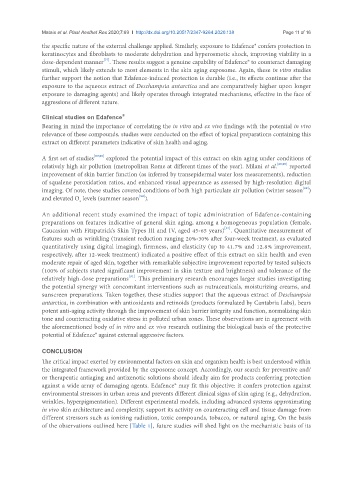Page 819 - Read Online
P. 819
Mataix et al. Plast Aesthet Res 2020;7:69 I http://dx.doi.org/10.20517/2347-9264.2020.138 Page 11 of 16
the specific nature of the external challenge applied. Similarly, exposure to Edafence® confers protection in
keratinocytes and fibroblasts to moderate dehydration and hyperosmotic shock, improving viability in a
[77]
dose-dependent manner . These results suggest a genuine capability of Edafence® to counteract damaging
stimuli, which likely extends to most elements in the skin aging exposome. Again, these in vitro studies
further support the notion that Edafence-induced protection is durable (i.e., its effects continue after the
exposure to the aqueous extract of Deschampsia antarctica and are comparatively higher upon longer
exposure to damaging agents) and likely operates through integrated mechanisms, effective in the face of
aggressions of different nature.
Clinical studies on Edafence ®
Bearing in mind the importance of correlating the in vitro and ex vivo findings with the potential in vivo
relevance of these compounds, studies were conducted on the effect of topical preparations containing this
extract on different parameters indicative of skin health and aging.
A first set of studies [89,90] explored the potential impact of this extract on skin aging under conditions of
relatively high air pollution (metropolitan Rome at different times of the year). Milani et al. [89,90] reported
improvement of skin barrier function (as inferred by transepidermal water loss measurements), reduction
of squalene peroxidation ratios, and enhanced visual appearance as assessed by high-resolution digital
[89]
imaging. Of note, these studies covered conditions of both high particulate air pollution (winter season )
[90]
and elevated O levels (summer season ).
3
An additional recent study examined the impact of topic administration of Edafence-containing
preparations on features indicative of general skin aging, among a homogeneous population (female,
[91]
Caucasian with Fitzpatrick’s Skin Types III and IV, aged 45-65 years) . Quantitative measurement of
features such as wrinkling (transient reduction ranging 20%-30% after four-week treatment, as evaluated
quantitatively using digital imaging), firmness, and elasticity (up to 41.7% and 12.8% improvement,
respectively, after 12-week treatment) indicated a positive effect of this extract on skin health and even
moderate repair of aged skin, together with remarkable subjective improvement reported by tested subjects
(100% of subjects stated significant improvement in skin texture and brightness) and tolerance of the
relatively high-dose preparations . This preliminary research encourages larger studies investigating
[91]
the potential synergy with concomitant interventions such as nutraceuticals, moisturizing creams, and
sunscreen preparations. Taken together, these studies support that the aqueous extract of Deschampsia
antarctica, in combination with antioxidants and retinoids (products formulated by Cantabria Labs), bears
potent anti-aging activity through the improvement of skin barrier integrity and function, normalizing skin
tone and counteracting oxidative stress in polluted urban zones. These observations are in agreement with
the aforementioned body of in vitro and ex vivo research outlining the biological basis of the protective
potential of Edafence® against external aggressive factors.
CONCLUSION
The critical impact exerted by environmental factors on skin and organism health is best understood within
the integrated framework provided by the exposome concept. Accordingly, our search for preventive and/
or therapeutic antiaging and antixenotic solutions should ideally aim for products conferring protection
against a wide array of damaging agents. Edafence® may fit this objective: it confers protection against
environmental stressors in urban areas and prevents different clinical signs of skin aging (e.g., dehydration,
wrinkles, hyperpigmentation). Different experimental models, including advanced systems approximating
in vivo skin architecture and complexity, support its activity on counteracting cell and tissue damage from
different stressors such as ionizing radiation, toxic compounds, tobacco, or natural aging. On the basis
of the observations outlined here [Table 1], future studies will shed light on the mechanistic basis of its

